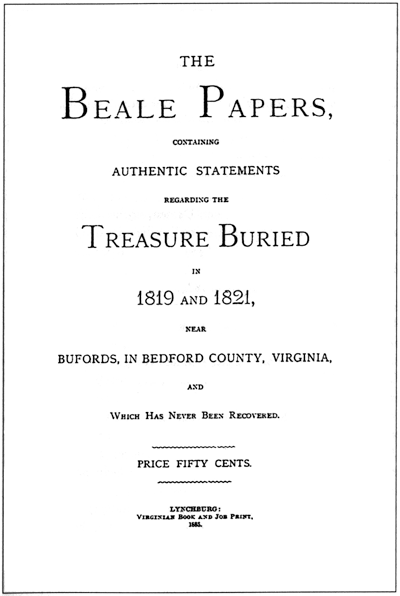Cryptic Codes: The Beale Ciphers
Decipher this code and discover the location, somewhere in Virginia, of buried treasure of gold, silver, and jewels.
In 1818, a man, named Thomas Jefferson Beale, led a hunting party of about thirty men across the American West. While hunting buffalo, they unexpectedly stumbled upon a large deposit of gold and silver. Fearing for the safety of their find in the lawless Wild West, beginning in 1819, they made two trips across the country and moved their treasure to the safety of Virginia. Here they buried it, along with some jewels acquired in St. Louis, in a stone vault, six feet underground, in an undisclosed site in Bedford County. Here lies approximately 1,300 kilograms of gold and 2,300 kilograms of silver, worth an estimated 65 million in present-day American dollars.
In 1822, before embarking on a third trip west to retrieve more of the treasure, Beale left a sort of insurance policy with a reliable friend, Robert Morriss, a Lynchburg innkeeper. Along with two explanatory letters, Beale placed in an iron strongbox three encrypted messages that detailed the exact location of the vault, its contents, and the names of the men in the expedition along with their next of kin. Beale left this locked box with Morriss.
While in St. Louis, Beale wrote Morriss another letter stating that if he or a member of his party did not return within ten years, he was to open the box and follow the instructions inside, to divide the treasure among the listed next of kin. At this time, another letter would be sent from an acquaintance in St. Louis which would contain the necessary keys needed to decipher the letters.
Ten years passed and no one came to claim the strongbox. Nor did any letter, containing the keys needed to decrypt the coded letters, arrive from St. Louis. Waiting thirteen more years, just to make sure, Morriss finally opened the box, examined the contents, and spent the rest of his life unsuccessfully trying to break the codes. Shortly before his death, he passed the box and its contents along with the explanatory letters to one of his friends, James Ward.
It was now Ward's turn to try his luck in deciphering the location of the buried treasure. He was partially successful; he decoded the one letter that listed the contents of the vault, but was unable to crack the other two. Beale had used a technique known as a book cipher, with a few modifications, to encrypt the messages.
A Book Cipher
To create a simple book cipher, one must start with a book or a document and then consecutively number each word in it. This becomes the key. Next, to create the cybertext, one peruses the key, searching for the word that is to be decoded and then write down its number. For example, using this paragraph as the key, the message 7 21 25 14 5 translates to "One (the seventh word in the paragraph) word becomes a book".
Beale used a version of the American "Declaration of Independence" as the key for encrypting his second message. But instead of the word-to-word translation in a normal book cipher, Beale employed a letter-to-letter encryption, that is, the number in the coded message corresponded to the first letter of that word in the "Declaration of Independence". For example, if the key was "stars twinkle at night always" and the cipher text is 1 3 4 2 5, then this would translate to "santa" (the "s" in santa corresponding to the first letter of the first word, the "a" to the first letter of the third word, and so on).
After twenty years of trying to decipher the remaining two letters, with no success, Ward published the letters and the coded messages, with his translation of the second, along with a brief history of the treasure, in a pamplet. He challenged the public to solve this puzzle and to find the treasure.
A Hoax?
Many scholars believe that the remaining two undeciphered messages are hoaxes. Several have questioned why Beale would have bothered creating three different, complicated book codes to mask what is in fact a single message. Also the letters contain several words, like "stampede" that were not in common use at the time the letters were written. There is also no census record that confirms Thomas Beale's existence. It has been suggested that the pamphlet may have been written by Edgar Allan Poe as a final riddle, with no solution, to bequeath to the future.
Regardless, many have meticulously scrutinzed these two pages filled with numbers. The Magna Carta, the United States Constitution, and all the books of the Bible have been used as possible keys to break the code. And for the past century, people have been randomly digging in various places in Bedford County on hunches where the treasure may be buried. Some have even been arrested for tresspassing, for digging holes on public lands and even in a cemetary. A ton of gold and a ton of silver provides a lot of motivation.
